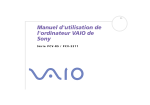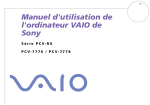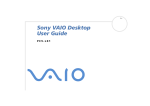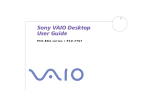Download Sony PCV-RX742 Help Guide
Transcript
Welcome Congratulations on your purchase of the Sony VAIO Digital Studio computer! Your new, high-performance, multimedia computer combines audio, video, and information technology features. About Your VAIO Digital Studio Computer To Unpack Your Computer To Choose an Ergonomic Location Click here to find the latest updates and supplemental information about your computer. Page 1 About Your VAIO Digital Studio Computer Your computer may not be equipped with all of the hardware features listed in this section. To view the specific hardware configuration for your system, see the Specifications sheet. VAIO AV applications This suite of Sony original applications includes Smart Capture, DVgate , DigitalPrint, SonicStage , and MovieShaker . These software applications make it easy to use advanced multimedia techniques to develop your personal audio and video creations. Using the i.LINK ports, you can capture, view, and share both still and video images, then catalog your work for fast, easy storage and retrieval. DVD-RW drive (not available on all models) This optical storage technology provides increased storage capacity and a dynamic multimedia computing experience. Your state-of-the-art DVD-RW drive writes to DVD-R/DVD-RW and CD-R/CD-RW media, and plays your favorite DVDs and CDs. This drive also functions as the ideal solution for making backups and archiving data, with the ability to store up to 4.7 GB of data on a single DVD-R/DVD-RW media (You can store up to 650 MB of data on a single CD-R/CD-RW media). Save movies, videos and still images to share with family and friends. Your DVD-RW drive does not support high-speed writing to a CD-R/CD-RW media. Verify that your CD-R/CD-RW media supports writing speeds of 2X or lower. DVD-ROM drive (not available on all models) This optical storage technology provides increased storage capacity and a rich multimedia computing experience. Your DVD-ROM drive plays both DVDs and CDs. CD-RW drive (not available on all models) This drive is the ideal solution for making backups and archiving data, with the ability to store up to 650 MB of removable, rewritable storage on a single rewritable CD. Save your movies to CD-R or CD-RW media and share videos and images with family and friends. CD-ROM drive (not available on all models) You can play your favorite audio and video CDs using this high-quality CD-ROM drive. i.LINK (IEEE 1394) interface Two built-in i.LINK ports, located on the front and rear panels, provide you with digital connection capability. The i.LINK name and logo identify a high-speed communication interface, which allows you to easily connect compatible digital camcorders. i.LINK is a trademark of Sony used only to designate that a product contains an IEEE 1394 connection. The i.LINK connection may vary, depending on the software applications, operating system and compatible i.LINK devices. All products with an i.LINK connection may not communicate with each other. Please refer to the documentation that came with your compatible i.LINK device for information on operating conditions and proper connection. Before connecting compatible i.LINK PC peripherals to your system, such as an optical or hard disk drive, confirm their operating system compatibility and required operating conditions. VAIO Smart keyboard This PS/2® keyboard has programmable shortcut buttons for launching your favorite programs or accessing the Internet. Sony audio and video quality Take advantage of today's advanced multimedia applications, games, and entertainment software with the Sony high-fidelity audio system, high-powered 3-D graphics, and "Sony-Tuned" MPEG digital video playback. Page 2 Microsoft® Windows® XP operating system Your system includes this latest consumer operating system from Microsoft. Preinstalled software All the software on your computer is preinstalled, configured, and ready for you to use right out of the box. Communications You have the choice of a variety of popular online services to browse the Internet, access e-mail, send faxes, and much more. Exceptional performance Your computer includes an AMD Athlon modem.1 1 XP processor, a 10BASE-T/100BASE-TX Fast Ethernet interface, and a V.90 data/fax A c tual upload and download s peeds may vary due to line c onditions , I SP s upport, and government regulations . Page 3 To Unpack Your Computer Com puter and accessories Manuals VAIO Digital Studio Com puter Quick Start — Provides basic information on setting up and registering your computer. The Quick Start also provides software and support information. The VAIO Digital Studio Com puter User Guide — Contains information on the hardware and preinstalled software applications included with your system. To access the online manual: 1. Click Start in the Windows taskbar, then click VAIO Help and Support. 2. From the VAIO Help and Support menu, click VAIO User Guide. Safety Inform ation — Supplies the safety and legal information about your VAIO computer. Specifications — Describes the hardware and physical configurations of your VAIO computer. Microsoft® Windows XP® Guide — Explains how to use the basic features of the Windows® operating system. Recovery CDs System Recovery CD(s) — Restore the software that shipped with your computer if it becomes corrupted or is erased. System Recovery CDs can only be used to restore the hard disk of the Sony computer you purchased. Application Recovery CD(s) — Reinstall individual software applications or drivers, if they become corrupted or are erased. Software Library The Software Library contains the Microsoft software license agreement and the Sony end-user license agreement. Page 4 To Choose an Ergonomic Location Before you get started, find the best location for your new computer. Planning your workspace Stable work surface — Use a stable work surface large enough to support the computer and other peripheral equipment. Ventilation — Leave at least eight inches of space on the left and back sides of your computer to enable proper ventilation. Placement of the keyboard, mouse, and other input devices — Place your keyboard, mouse, and other input devices so that your arms and hands are in a relaxed, comfortable position. The keyboard should be directly in front of you. Adjust the level of the keyboard so that your lower arms are parallel to the floor. Keep your wrists in a relaxed position when you are using the keyboard—not angled up or down. Use the palmrest only briefly, for resting. While typing, never use the palmrest or rest your hands on the table. Position the mouse at the same level as the keyboard. Hold the mouse with a relaxed hand, and use your whole arm to move it. Take breaks during sessions with your computer. Excessive use of the mouse or a joystick may strain muscles or tendons. Furniture and posture — Sit in a chair with good back support and armrests. Adjust the level of the chair so your feet are flat on the floor. A footrest may make you more comfortable. Sit with relaxed, upright posture—avoid slouching forward or leaning far backward. Viewing angle of the display — Position the display 18 to 26 inches directly in front of you, with the top of the screen at or a little below eye level. Use the display's tilting feature to find the best position. You can reduce eye strain and muscle fatigue by placing the display in the proper position. Lighting — Choose a location where windows and lights do not create glare and reflection on the display. Use indirect lighting to avoid bright spots on the display. You can also purchase accessories for your display that help reduce glare. Proper lighting adds to your comfort and work effectiveness. Page 5 Locating Controls And Connectors Your computer may not be equipped with all of the hardware features listed in this section. To view the specific hardware configuration for your system, see the Specifications sheet. Front Panel Overview Back Panel Overview Page 6 Front Panel Overview The front panel of your VAIO Computer enables access to the optical and floppy disk drives. It also includes Universal Serial Bus (USB) and i.LINK® ports to connect compatible peripheral devices. i.LINK is a trademark of Sony used only to designate that a product contains an IEEE 1394 connection. The i.LINK connection may vary, depending on the software applications, operating system and compatible i.LINK devices. All products with an i.LINK connection may not communicate with each other. Please refer to the documentation that came with your compatible i.LINK device for information on operating conditions and proper connection. Before connecting compatible i.LINK PC peripherals to your system, such as an optical or hard disk drive, confirm their operating system compatibility and required operating conditions. Front panel 1 Optical drive 1 See Specifications sheet for optical drive information. 2 Optical drive 2 See Specifications sheet for optical drive information. 3 Floppy disk drive Reads and writes data from and to a 3.5-inch floppy disk. Page 7 4 Floppy disk drive access indicator light Lights in green while reading and writing data from and to a floppy disk. 5 Optical drive access indicator light Lights in amber while reading and writing data from and to the optical drives. 6 Hard disk drive access indicator light Lights in amber while reading and writing data from and to the hard disk. 7 Power switch and indicator light Turns the computer on/off. The indicator light is blue while the power is on and amber when the computer is in Stand by mode. 8 Optical drive 1 eject button Ejects a disc from Optical drive 1. 9 Optical drive 2 eject button Ejects a disc from Optical drive 2. 10 Floppy disk eject button Ejects a floppy disk. 11 Universal Serial Bus (USB) ports (2) Connections for compatible USB devices. 12 i.LINK 4-pin port (IEEE 1394) Connection for a compatible digital device. For your convenience, your computer includes USB and i.LINK ports on both the front and back panels. The 4-pin i.LINK port is located on the front panel and the 6-pin i.LINK port is located on the back. Page 8 Back Panel Overview The back panel of your computer contains the ports for supplied and optional accessories. The icons on the back panel locate and identify the ports on your computer. Back panel 1 Mouse port Connection for a PS/2® mouse. 2 Keyboard port Connection for a PS/2 keyboard. 3 Universal Serial Bus (USB) ports (2) Connections for compatible USB devices. 4 Ethernet port Connection for a 10BASE-T/100BASE-TX Fast Ethernet interface. (The port marked with 5 (Network) is for LAN connections only.) Monitor port Page 9 Connection for a display. 6 Printer port Connection for a parallel device, such as a printer or scanner. 7 i.LINK 6-pin port (IEEE 1394) Connection for a compatible digital device. 8 Serial port Connection for a compatible serial device. 9 Headphones jack Connection for the supplied speakers or optional headphones. 10 Line In jack Connection for an audio device. 11 Microphone jack Connection for a microphone (optional). 12 Modem line jack Connection for the supplied modem cable to the wall jack. 13 AC Input port Connection for the supplied power cord. 14 Telephone jack Connection for a telephone cable (optional) to the computer. i.LINK is a trademark of Sony used only to designate that a product contains an IEEE 1394 connection. The i.LINK connection may vary, depending on the software applications, operating system and compatible i.LINK devices. All products with an i.LINK connection may not communicate with each other. Please refer to the documentation that came with your compatible i.LINK device for information on operating conditions and proper connection. Before connecting compatible i.LINK PC peripherals to your system, such as an optical or hard disk drive, confirm their operating system compatibility and required operating conditions. Page 10 Setting Up Your VAIO Digital Studio Computer Your computer has many new and exciting features. This section contains information on setting up your computer and connecting peripheral devices. To Set Up Your Computer To Turn on Your Computer To Register Your Computer To Set Up Your Dial-up Connection To Set Up Power Management Modes To Shut Down Your Computer Page 11 To Set Up Your Computer Your computer may not be equipped with the same hardware features shown in this section. See the Specifications sheet for your system's configuration. Page 12 Connecting a display (monitor) 1. Plug the display cable into the Monitor port. 2. If necessary, plug the display cable into the rear of the display. Connecting a display Install your equipment so that you can easily reach the power outlet in the event of an emergency. Page 13 Connecting the speakers 1. Plug the cable attached to the left speaker into the L Out jack on the back of the right speaker. 2. Plug the cable attached to the right speaker into the Headphones jack. 3. Plug the jack end of the AC adapter cord into the DC In jack on the back of the right speaker and plug the other end into a grounded AC wall outlet or power strip. Connecting the speakers Page 14 Connecting the keyboard and mouse 1. Plug the keyboard cable into the Keyboard port on the back of the computer. 2. Plug the mouse cable into the Mouse port. Connecting the keyboard and m ouse Page 15 Connecting the modem cable 1. Unplug your telephone from the wall jack. 2. Plug the modem cable (supplied) into the Modem line jack on the computer, and then plug the other end of the cable into the wall jack. Connecting the m odem cable Your computer has a protective sticker covering the Ethernet port located on the rear panel. Connect only 10BASE-T and 100BASE-TX cables to the Ethernet port. Using other cables or a telephone cable may result in an electric current overload and can cause a malfunction, excessive heat or fire in the port. For help on connecting to a network, see your network administrator. Page 16 Connecting the power cords 1. Plug the power cord into the back of the computer. 2. Plug both the display and power cords into a grounded AC wall outlet or a power strip. Connecting the power cords Page 17 To Turn on Your Computer Turning on your computer 1. Press the power switch on the computer to turn on the power. 2. Press the power switch on the display to turn on the power. 3. Press the power switch on the right speaker to turn on the power. Turning on your com puter When you start your system for the first time, your computer may detect new equipment and display a dialog box that asks you to restart your computer. Please respond to this request immediately. Page 18 To Register Your Computer Take advantage of Sony's commitment to quality customer support and receive these benefits by registering your computer: Sony Customer Support — Communicate with a Support Representative to troubleshoot problems you may be having with your computer. Limited warranty — Protect your investment. See the Warranty Card for more details. You are prompted to register your computer the first time you turn on the unit. Follow the on-screen instructions to complete the registration process. If you are not able to register your computer during the first session, you are provided with additional registration opportunities later. Page 19 To Set Up Your Dial-up Connection The first time you turn your computer on, follow these steps to set up your dial-up connection: 1. Click Start from the Windows taskbar and select All Programs. 2. Point to Accessories, point to Communications, and then click New Connection Wizard. The Location Information window appears. Location Inform ation window 3. Enter in your information as requested. Click OK. The Phone and Modem Options window appears. Phone and Modem Options window 4. Click to select your dialing location and then click OK. The New Connection Wizard appears. New Connection Wizard window Page 20 5. Follow the on-screen instructions to finish setting up your dial-up connection. Page 21 To Set Up Power Management Modes When you plan to stop using your computer for a short period of time, you can set your system to automatically enter a power management mode. Your computer may have difficulty resuming from a power-saving mode, if the power scheme is not set up correctly. Setting up your system's power management Sony recommends following these steps for optimum power management: 1. Click Start in the Windows® taskbar and select Control Panel. 2. Select Performance and Maintenance. The Performance and Maintenance window appears. 3. Click Power Options. The Power Options Properties window appears. 4. Click the Hibernate tab and verify that the Enable hibernation check box is selected. Click Apply. 5. Click the Power Schemes tab. Select the Home/Office Desk power scheme. 6. In the section, "Settings for Home/Office Desk power scheme," use the drop-down list to set a time value for System stand by or System hibernates. Do not set time values for both settings. Click Apply. 7. Click the Advanced tab. In the Power buttons section, "When I press the power button on my computer," use the drop-down list and select Hibernate. Click Apply. 8. Click OK. Your computer is set to enter a power-saving mode automatically. You can resume from this mode by briefly pressing the power button on your computer. Stand by mode indicators You can identify power management mode the computer is in by the color of the power indicator light. Color Mode Amber Computer is in Stand by mode. Blue Computer is in Normal mode, ready to use. No color Computer is turned off or in Hibernate mode. Page 22 To Shut Down Your Computer When you are ready to turn off your computer for an extended period of time, use this procedure. To avoid loss of data, do not use the Power switch to turn off the computer. Turning off your computer 1. Click Start in the Windows taskbar and select Turn Off Computer. The Turn Off Computer dialog box appears. 2. Select the Turn Off option. Respond to any prompts about saving your documents. 3. Wait for your computer to turn off automatically—the power indicator light turns off. 4. Turn off any peripheral devices connected to your computer. If you plan to turn off your computer for a short period of time, you may want to use Stand by mode instead. About the power switch If your system stops responding, press and hold the Power switch for more than six seconds to force your system to shut down. You may need to repeat this procedure if your system does not shut down on the first attempt. Page 23 Configuring Your VAIO Computer This section provides basic information on maintaining your computer's hard disk drive performance, using i.LINK devices, and changing default settings. About Your Hard Disk Drive Partition i.LINK Compatibility VAIO Action Setup To Change the Sony Software Window Design Page 24 About Your Hard Disk Drive Partition To maintain optimum system performance, you should defragment your computer's D partition regularly. To improve the performance of Sony audio and video software applications, the hard disk drive on your computer has been formatted with two partitions, C and D. Some Sony software applications save files to the D partition. This prevents large video captures from consuming the available space on your C partition. Page 25 Defragmenting your hard disk drive If you encounter frame dropping while recording digital video onto your hard disk drive, defragmentation may be necessary. 1. Deactivate your screen saver and close other open applications, if applicable. 2. Click Start in the Windows taskbar and select All Programs. 3. Point to Accessories, point to System Tools, and then select Disk Defragmenter. The Disk Defragment dialog box appears. 4. Select Action from the menu bar and click Analyze. It may take more than a couple of hours to complete defragmentation, depending on the data capacity and current utilization of your computer's hard disk drive(s). Page 26 i.LINK Compatibility Your VAIO computer may include either 4-pin or 6-pin, or both types, of i.LINK ports. i.LINK is a trademark of Sony used only to designate that a product contains an IEEE 1394 connection. The i.LINK connection may vary, depending on the software applications, operating system and compatible i.LINK devices. All products with an i.LINK connection may not communicate with each other. Please refer to the documentation that came with your compatible i.LINK device for information on operating conditions and proper connection. Before connecting compatible i.LINK PC peripherals to your system, such as an optical or hard disk drive, confirm their operating system compatibility and required operating conditions. A 6-pin i.LINK port can: supply power from the computer to the connected device if the device is equipped with a 6-pin connector. supply 10V to 12V. A 4-pin i.LINK port cannot supply power to a connected device. The total power supplied by the 6-pin i.LINK port cannot exceed 6 watts. The following Sony i.LINK 400 Mbps cables are available and recommended for use with your computer: VMC-IL4415, VMC-IL4435, VMC-IL4615, VMC-IL4635, VMC-IL6615, and VMC-IL6635. Sony computer supplies, accessories, and peripherals can be purchased from your local retailer, from the Sony VAIO Direct Web site at http://vaio.sonystyle.com, or by calling 1-888-315-7669 (toll free). Page 27 Connecting an i.LINK (IEEE 1394) device 1. Use the symbol to locate the i.LINK port on your compatible i.LINK device and on your computer. Plug the i.LINK cable connector into this port. 2. Plug the other end of the cable into the corresponding 4- or 6-pin i.LINK port on your computer. See the instructions that came with your i.LINK device for more information on installation and use. Page 28 VAIO Action Setup VAIO® Action Setup manages the settings for your computer's Shortcut keys (S Keys). Shortcut Keys The programmable S Keys are set to launch the following applications: S1 — Microsoft® Outlook® Express S2 — Microsoft® Internet Explorer S3 — SonicStage S4 — DigitalPrint S5 — MovieShaker S5 — Giga Video Recorder (On selected models equipped with Giga Pocket features.) S6 — VAIO® Help and Support Page 29 Changing the settings of the S keys You can reprogram the S keys to launch other applications. 1. Click Start in the Windows taskbar and select All Programs. 2. Select VAIO Action Setup, then click VAIO Action Setup. You can also double-click Setup. the VAIO Action Setup icon, located in the Windows taskbar, to launch VAIO Action 3. Click the S Key you want to change. 4. From the Select Application dialog box, click the option for the desired type of function. The corresponding applications appear in the list box on the right. 5. Select an application from the list. Click Next. You can drag an application to place it into the list box. 6. The Confirmation Application Name window appears. Click Next. 7. You may now type a new name and description, if desired. Then click Finish. Page 30 To Change the Sony Software Window Design You can select from different window designs for your Sony software and create your own personal computing environment. Page 31 Changing the window design 1. Click Start in the Windows taskbar and select the Control Panel. 2. Click Other Control Panel Options. 3. Click UI Design Selector. 4. Click << or >> and select the desired design. 5. Click Apply. 6. The "UI Design Selector" window design changes. The window design for your Sony software will match the "UI Design Selector" window. 7. To try another selection, click << or >>, then click Apply. 8. When you have made your selection, click OK. The UI Design Selector closes and the Sony software window design displays. You may only use this feature with compatible UI Design Selector software. Page 32 About The Software On Your Computer Your VAIO® computer is ready to help you work, play, learn, and communicate as soon as you turn it on. This section provides an overview of the software titles preinstalled on your computer. Overview Of Preinstalled Software Applications For Answers To Your Software Questions Page 33 Overview Of Preinstalled Software Applications Your computer may not include all of the software applications listed, depending on the system configuration you purchased. Adobe® Acrobat Reader® Adobe Systems Inc. Acrobat Reader software allows you to view, navigate, and print electronic documents in Adobe's Portable Document Format (PDF), an open file format that is intended to preserve the fidelity of documents created on all major computer platforms. Adobe® Photoshop® Elements (On selected models) Adobe Systems Inc. Using state-of-the-art image editing tools, you can unleash your artistic ability and create digital images for print, e-mail and posting to the Web. The versatile image capturing options allow you to start working with digital and traditional photos immediately. Explore endless creative possibilities for your personal images with Adobe Photoshop Elements. Adobe® Premiere® LE (On selected models) Adobe Systems Inc. Adobe Premiere LE offers interface and editing tools for producing movies for video, multimedia, or the Web. View source clips and edited footage simultaneously on-screen. You can create your own personal video clips that are up to three hours in length, with complete audio-video synchronization. America Online® America Online, Inc. America Online is a popular Internet online service. Stay in touch with family and friends with easy-to-use e-mail. Manage your personal finances, get the latest news and sports scores, and chat with thousands of others who share your interests. DigitalPrint Sony Electronics Inc. This image management software makes it fun and easy to edit, import, and organize your digital pictures in a photo album for rich digital printing to any standard color laser or inkjet printer. Digital Print can also be used to make custom CD labels for your audio CDs. DVgate Sony Electronics Inc. Connect a digital video camera recorder to the i.LINK® port and capture your own video clips and still images. You can edit clips from your video, add new clips, and combine clips into new movie segments. You can also save your images in a variety of popular file formats. DVDit! for VAIO (On selected models) Sonic Solutions DVDit! is a new and exciting production software that is easy to use. DVDit! has easy-to-use features, that automatically convert your multimedia source files into the correct format for recording onto a DVD-R or CD-R, or a DVD folder on your system hard drive. You can combine your favorite MPEG and digital stills, creating professional quality DVDs. EarthLink Network Total Access EarthLink Network Inc. An Internet Service Provider that supplies access, information, and assistance to its customers, introducing them to the Internet. Member benefits include e-mail, newsgroups, a Personal Start Page, a free 6 MB Web site, a member magazine, and 24-hour technical support. Giga Pocket Personal Video Recorder (On selected models) Sony Electronics Inc. Giga Pocket Personal Video Recorder is a unique set of hardware and software components that provide you with excellent TV viewing, recording and playback experiences. You can watch and record your favorite TV programs from your computer, create custom playlists, and play your Video Capsules on other computers. Giga Pocket enables your computer, TV, VCR, and other video player devices to work in harmony. Microsoft® Internet Explorer Microsoft Corp. Page 34 Internet Explorer delivers the World Wide Web the way you want it. It's secure, easy to use, and you can personalize how you access the Internet. Outlook Express and other features of Internet Explorer deliver a great Internet experience. Microsoft Office XP Professional (On selected models) Microsoft Corp. Microsoft Office XP redefines the relationship between people and software by providing a smarter, simpler way of working. New Office XP features include context-sensitive smart tags, enhanced formatting options, and more, that enable you to continually integrate additional services into Office and access information anytime. Microsoft Office XP Small Business Edition (On selected models) Microsoft Corp. With Microsoft Office XP you'll find a powerful new technology that will help you get work done more quickly by providing real-time, context-sensitive options for important actions, from formatting to error correction. Task panes consolidate important tasks into a single integrated view, enabling you to conduct searches, launch and format documents, and view the contents of your Clipboard from one location. Microsoft® Outlook® Express Microsoft Corp. This messaging tool that takes your e-mail and newsgroup communications to new heights. Outlook Express is easy to set up and use, and provides you with secure, personalized, and comprehensive features that protect and enhance your online communication experience. Microsoft® Word (On selected models) Microsoft Corp. Microsoft Word makes it easy to create common Web, e-mail, and print documents for use around the world. It embraces HTML as a first-class file format and extends Word's ease-of-use to the Web and e-mail. Word also extends that ease-of-use to international users, making it easy to create multilingual documents. MovieShaker Sony Electronics Inc. Sony's original MovieShaker software creates personal movies that have transitions, background music, and text. Just import your video clips and "shake" with a click of the mouse. Your personal movies are easy to create and fun to share with family and friends. PC-Cillin® 2000 Trend Micro, Inc. PC-Cillin provides portable, easy-to-use, real-time antivirus security at your computer's entry point (beaming, synchronization, Internet access) to defend against potential threats hidden inside files, e-mail, or on the Web. PicoPlayer Sony Electronics Inc. PicoPlayer software is a video player application that enables you to use Giga Pocket Personal Video Recorder functions on a computer that does not have Giga Pocket Personal Video Recorder installed. You can play Video Capsules created by Giga Pocket Personal Video Recorder. If a Giga Pocket equipped computer is available on your home network, you can use PicoPlayer to watch TV and use the Giga Pocket Server's TV programming and recording functions. PowerDVD CyberLink Corp. PowerDVD software offers high-quality playback of DVD movies on your computer. PowerDVD software includes all the controls you expect from a home DVD player, plus a range of additional features. For example, you can bookmark scenes to come back to them later. The customizable controls, advanced navigation bar, and dynamic player skins combine to deliver a premium viewing experience. Quicken® 2002 Intuit Inc. Quicken is the fastest, easiest way to organize your finances. Quicken works just like your checkbook, so it's easy to learn and use. You can even pay your bills online. Quicken manages all of your finances, bank accounts, credit cards, investments, and loans. RealPlayer® RealNetworks Inc. RealPlayer is a high-quality streaming media player that supports many digital media formats. The user-friendly interface Page 35 has enhanced navigation capabilities, allowing you to access and enjoy audio and video programming over the Internet. RealPlayer is your gateway to a superb Internet multimedia experience. RecordNow DX (On selected models) VERITAS Software Corp. RecordNow is the ideal DVD/CD disc mastering software for all your simple recording needs. The new RecordNow DX wizard makes it easy for the novice user to start recording right away, while the more advanced user will appreciate extended features such as recording jobs, a detailed activity log, and the ability to customize drive settings. Simple DVD Maker (On selected models) Sony Electronics Inc. Simple DVD Maker software enables you to write Giga Pocket Video Capsules and video Playlists to DVD-R/DVD-RW media, using DVD video format. The DVDs that you create can be played back with compatible DVD players and computers that have compatible DVD drives. Smart Capture Sony Electronics Inc. Smart Capture is a fun new way to send multimedia messages via e-mail. Smart Capture manages the i.LINK connection between your notebook and a Sony Digital Handycam Camcorder that supports the i.LINK interface. It allows you to capture compressed video or still images and save them to your hard disk drive or share via e-mail. A smart solution for computer, digital audio/video and network convergence. SonicStage for VAIO® (On selected models) Sony Electronics Inc. The SonicStage jukebox application from Sony adds a host of new features to its predecessor, OpenMG Jukebox. Continuing to take advantage of Sony's copyright-protected ATRAC3 format for high-quality digital audio storage, SonicStage software sports a new music visualizer, a sleek new player skin design, audio CD burning capability, and a parametric equalizer for fine-tuning audio playback. SonicStage Premium (On selected models) Sony Electronics Inc. SonicStage Premium software is a special jukebox application that supports high quality digital audio playback and recording from the NetMD , FM Tuner, and DVD-RW devices in your VAIO® MX Desktop PC. Recording from external analog and digital audio devices, such as CD players and MiniDisc players, is also supported. SonicStage Premium software includes several standard jukebox features, including a music visualizer, audio CD burning capability, and a parametric equalizer for fine-tuning audio playback. Sony on Yahoo! Yahoo! Inc. Personalize your own web portal with Sony on Yahoo! Get a free webmail account, customized news and local weather reports, comics, and more. VAIO Action Setup Sony Electronics Inc. VAIO Action Setup manages the settings for your computer's Shortcut keys. WordPerfect® Office 2002 Standard Corel Corp. WordPerfect ® Office 2002 Standard software includes all the applications you need to create professional-looking documents, newsletters, reports, presentations, and brochures while incorporating graphics, spreadsheets, charts, and tables with ease. This comprehensive suite includes the popular WordPerfect® 10 word processor, the Quattro® Pro 10 spreadsheet program, the Corel® Presentations 10 presentation program, and a wide range of additional productivity-enhancing features. Page 36 For Answers To Your Software Questions Check this support listing to locate support information for your computer's preinstalled software applications from the Internet, by e-mail, or by telephone. Your computer may not be supplied with all of the software applications listed, depending on the system configuration you purchased. Adobe® Acrobat Reader®, Photoshop® Elements, Premiere® LE (On selected models) (Adobe Systems Inc.) Web site http://www.adobe.com telephone 206-675-6126 (fee-based support) fax 206-628-5737 e-mail [email protected] hours M - F, 6 AM - 5 PM PST America Online® (America Online, Inc.) Web site http://www.aol.com telephone hours 800-827-6364 7 days a week, 24 hours a day DVDit!® for VAIO (On selected models) (Sonic Solutions) Web site http://www.dvdit.com Online Support http://www.dvdit.com/support telephone 877-DVD-1124* e-mail [email protected] hours M - F, 9 AM - 6 PM PST * T elephone s upport is fee-bas ed per inc ident and available only within the U .S. and C anada. O nline s upport is free of c harge. EarthLink Network Total Access (EarthLink Network Inc.) Web site http://help.earthlink.net/techsupport telephone 800-395-8410 e-mail [email protected] hours 7 days a week, 24 hours a day Page 37 Microsoft® Windows® XP operating system, Internet Explorer, Office XP Professional (On selected models), Office XP Small Business Edition (On selected models), Outlook® Express, Word (On selected models) (Microsoft Corporation) Web site http://www.sony.com/pcsupport telephone 888-4-SONY-PC (888-476-6972)* hours 7 days a week, 24 hours a day * Support from 8 8 8 -4 -SO N Y -P C is free of c harge for 9 0 days after the original date of purc has e. PC-Cillin® 2000 (Trend Micro, Inc.) Web site http://www.antivirus.com/pc-cillin telephone 949-387-7800; 900-820-8324* e-mail [email protected] hours M - F, 8AM - 5PM PST * Support from 9 4 9 -9 8 7 -7 8 0 0 is free of c harge. Support from 9 0 0 -8 2 0 -8 3 2 4 is fee-bas ed. Quicken® 2002 Basic (Intuit, Inc.) Web site and Online support http://www.intuit.com/support telephone 900-555-4688 hours 7 days a week, 24 hours a day RealPlayer® (RealNetworks, Inc.) Web site http://service.real.com/rjoptions.html e-mail http://service.real.com/help/call.html RecordNow DX (VERITAS Software Corp.) Web site http://www.easy.co.jp/jrndx/sony telephone 800-326-9551* * T elephone s upport is provided by Sony. Sony Applications (Sony Electronics Inc.) Web site and Online support http://www.sony.com/pcsupport telephone 888-4-SONY-PC (888-476-6972)* hours 7 days a week, 24 hours a day * Support from 8 8 8 -4 -SO N Y -P C is free of c harge for 9 0 days after the original date of purc has e. WordPerfect® Office 2002 Standard (Corel Corporation) Web site http://www.corel.com/support/product_specific/wp10.htm Page 38 telephone 613-274-0500* hours M - F, 8:30 AM - 7:30 PM EST * Support from 6 1 3 -2 7 4 -0 5 0 0 is fee-bas ed. T he online s upport is free of c harge. Sony Service Center For the Sony Service Center nearest you, call 1-888-4-SONY-PC (1-888-476-6972). This service is free of charge for 90 days after the original date of purchase. Page 39 System and Application Recovery CD(s) You can restore your system, individual software applications, or drivers, using the Recovery CDs. To Use The System Recovery CD(s) To Use The Application Recovery CD(s) Page 40 To Use The System Recovery CD(s) The System Recovery CD utility formats your hard disk drive and restores the operating system and all the original, preinstalled software applications. If the operating system or applications become corrupted or are erased, you can restore your computer to the original factory settings. The System Recovery CD can only be used to restore the hard disk drive of the Sony computer you purchased. The System Recovery process removes all software that you may have installed since you started using your computer. Reinstall any applications that were not included with the computer when you purchased it. If you experience a problem with your computer, reinstalling an individual application or device driver may correct the problem. You may not need to recover the entire contents of your hard drive. Use the Application Recovery CD(s) to reinstall individual applications. When you successfully complete your system recovery, you are prompted to complete the Windows registration process. Page 41 System Recovery options System drive recovery All data on Drive C is deleted. The factory default settings and software applications are restored on this drive only. Change partition size All partitions, custom installations, and changes are removed from the hard disk drive. You can set the partition sizes for both the Drive C and Drive D. The original, preinstalled operating system and software applications are restored. Recovery to original factory defaults All data and partitions are removed from the hard disk drive. All original factory settings, operating system, and preinstalled software is restored. The System Recovery utility does not back up your system's data. If you wish to retain your system data, launch a back up to an external media. Page 42 Using the System Recovery CD(s) Your system may take a few minutes to load necessary files. A blue screen appears during the downloading process. 1. Insert the System Recovery CD in your computer's optical drive. The System Recovery utility starts from the optical drive. The first CD must be in the drive when you turn on your computer. If your system is equipped with two optical drives, insert the System Recovery CD into the upper optical drive. 2. Turn off your computer. 3. Wait 30 seconds and turn on your computer. Your screen displays the downloading progress, "Starting VAIO Recovery Utility." 4. The VAIO System Recovery Utility dialog box appears. Click Next. 5. At the pop-up prompt, select Yes to begin the system recovery process. Follow the on-screen instructions. Your system may include one or more System Recovery CDs. If you have more than one System Recovery CD, insert the first CD to run the System Recovery program. You are prompted to insert the next CD(s) once the information from the first CD has been installed. The recovery process takes approximately 30 to 60 minutes to complete. After recovering your system using the System Recovery CD(s), you may be prompted to insert your Application Recovery CD(s) after restarting Windows. Use the Application Recovery CD(s) to complete full restoration of your system. Page 43 To Use The Application Recovery CD(s) The Application Recovery CD utility enables you to reinstall individual software applications, individual drivers, and to repair software applications if they become corrupted or are erased. You can reinstall a software application or driver to correct a problem that you are experiencing with your computer, peripheral hardware, or specific software application. You may not need to reinstall the entire contents of your hard drive. If you need to reinstall all of the software that shipped with your computer, use the System Recovery CD(s). You must be in Windows to run the Application Recovery CD utility. Page 44 Reinstalling software applications 1. Turn on your computer. If your computer is already on, save and close all open applications. 2. When the Windows desktop appears, insert the Application Recovery CD #1 into your computer's optical drive. The Application Recovery utility loads automatically. If your system is equipped with two optical drives, insert the Application Recovery CD into the upper optical drive. 3. When the Application Recovery menu appears, follow the on-screen instructions to complete the recovery process. If you have any questions about using the Application Recovery CD(s), visit http://www.sony.com/pcsupport, or contact Sony Customer Support at 1-888-4-SONY-PC. Page 45 Reinstalling device drivers 1. Turn on your computer. If your computer is already on, close all applications. 2. When the Windows desktop appears, insert the Application Recovery CD #1 into the optical disc drive. 3. Click Start in the Windows taskbar and click Control Panel. The Control Panel window appears. 4. Click Performance and Maintenance and click System. The System Properties dialog box appears. 5. From the Hardware tab, click Device Manager. 6. Click to select the unknown device or the device that requires the driver installation. The unknown device(s) is identified by a yellow question mark. 7. From the Action menu, click Uninstall. This removes the device driver from your system. Click OK. Repeat for each device driver as necessary. 8. Restart your computer. Click Start in the Windows taskbar, select Turn Off Computer, and then click Restart. 9. When the desktop appears, Windows automatically reinstalls the device driver(s) from the Application Recovery CD. Your system includes one or more Application Recovery CDs. Insert Application Recovery CD #1, to start the application or driver recovery process. You are prompted to insert the next CD(s), depending on the software application or driver you wish to restore. Page 46 Frequently Asked Questions This section describes how to troubleshoot common problems you may encounter when using your computer. Many problems have simple solutions, so try these suggestions before using Support Resources. About VAIO Digital Studio Computer Functions About Changing Your System's Default Settings About Your System Recovery CDs About Using The Optical Disk Drive(s) About The Preinstalled Software About the Speakers About the Modem About the Microphone About the Mouse and Keyboard About Using a Peripheral Device Page 47 About VAIO Digital Studio Computer Functions My computer does not start. Check that the computer is plugged into a power source and that it is turned on. Check that the power light is lit on the front panel of the computer. Confirm that a disk is not in the floppy disk drive (unless you are using a bootable floppy disk). Confirm that the power cord and all cables are connected firmly. If you plugged the computer into a power strip or Uninterruptible Power Supply (UPS), make sure the power strip or UPS is turned on and working. Check that the monitor is plugged into a power source and turned on. Check that the brightness and contrast controls are adjusted correctly. See the manual that came with your display for details. Check that the computer is not in stand by mode. Why did my computer or software application stop responding? You can try to locate and close the software application that has stopped responding. 1. Press the Ctrl+Alt+Delete keys. The Windows Task Manager window appears. 2. From the Applications tab, locate the application that has the status message, "Not responding." 3. Select the application that has a Not Responding status and click End Task. Windows attempts to close the application. If your computer does not respond or the application does not close, try the following steps: 1. Save any open files, if possible. 2. Press the Alt+F4 keys. The Turn Off Computer window appears. 3. Click the Restart button. If your computer still does not respond and you cannot restart, shut down your computer by pressing and holding the power switch for more than six seconds. If the software application continues to stop responding or causes your computer to stop responding, contact the software publisher or designated technical support provider. Pressing and holding the power switch for more than six seconds, may result in the loss of data from files that are currently open. Why does the Windows operating system stop responding during shutdown? The Windows operating system may not shut down properly for many reasons, including incompatible or conflicting drivers, damaged files, or non-responsive hardware. For troubleshooting information, you can search Windows Help. 1. Click Start in the Windows taskbar and select VAIO Help and Support. The VAIO Help and Support Center appears. 2. Select Fixing a Problem and then select Startup and Shut Down problems. A list of specific problem topics appears on the right side of the dialog box. 3. Select Startup and Shutdown Troubleshooter. Follow the on-screen instructions according to your specific situation. I cannot find the Windows taskbar. The Windows taskbar may be hidden or minimized. Use the mouse to locate a hidden taskbar by pointing to the left, right, top, and bottom edges of the screen. The Page 48 taskbar appears when the cursor is placed over its location. 1. Right-click on the taskbar and select Properties from the shortcut menu. 2. Clear the check box for Autohide the taskbar, then click OK. Use the mouse to locate a minimized taskbar by pointing to the left, right, top and bottom edges of the display screen. The taskbar has been located when the cursor changes to a double arrow cursor. Left-click and drag away from the edge of the display screen. The minimized taskbar resizes and becomes visible. Why is my system running slowly? The system responsiveness varies depending with the number of applications that are open and running. Close any applications that you are not currently using. Increasing the system memory may also help. For information on installing memory, please see the online VAIO User Guide. Page 49 About Changing Your System's Default Settings How do I change the parallel port type to ECP, EPP, or bi-directional? You can change the parallel port type using the System Setup utility (CMOS Setup Utility). To access System Setup: 1. Click Start in the Windows taskbar and select Turn Off Computer. Select Restart. 2. When the Sony screen displays, press the F2 key on your keyboard. 3. Select the Advanced tab from the Setup Utility screen. 4. Select "I/O Device Configuration" and press Enter. 5. Use the arrow keys to highlight Parallel Port Mode and press Enter. You can toggle between the Normal (bi-directional), EPP, ECP, and ECP+EPP options using the directional arrow keys. 6. Select the desired setting displays, and press Enter. 7. Press the F10 key to Save and Exit. How do I change the video resolution of my display? 1. Click Start in the Windows taskbar and then select Control Panel. 2. Select Appearances and Themes, then select "Change the screen resolution." 3. Click the Settings tab. 4. Change the Screen resolution and Color quality to the desired levels. 5. Click Apply and then click OK. Page 50 About Your System Recovery CDs My files are corrupted or deleted. How do I recover software applications that came with my computer? See To Use The Application Recovery CD(s) for more information. My drivers are corrupted or deleted. How do I recover drivers that came with my computer? See To Use The Application Recovery CD(s) for more information. Page 51 About Using The Optical Disk Drive(s) Your computer may not be equipped with all of the hardware features listed in this section. To view the specific hardware configuration for your system, see the Specifications sheet. Why doesn't my optical drive tray open? Use the Eject button 1. Make sure the computer is turned on. 2. Press the Eject button on the drive. Use the My Computer icon 1. Click Start in the Windows taskbar, then select My Computer. 2. Right-click the appropriate optical drive icon. 3. Select Eject from the shortcut menu. Avoid using adhesive labels to identify your CD or DVD media. Adhesive labels may come off while the CD or DVD media is in use in your optical drive(s) and may cause damage to the unit. When I click an application icon, the message, "You must insert the application CD into your drive" appears and the software does not start. Some software applications require specific files that are located on the application's CD-ROM. Insert the disc and try starting the program again. Check to make sure you inserted the CD-ROM with the label side facing up. Why can't I play a DVD or CD media? After inserting your optical disc, wait a few seconds for it to be detected before trying to access it. Verify that the disc is in the tray with the label side facing up. Install your CD or DVD software according to the manufacturer's instructions. If your drive reads some DVDs or CDs, but not others, check the shiny side of the disc for dirt or scratches. To recover the CD or DVD software applications that are preinstalled on your computer, see To Use The Application Recovery CD(s) for more information. Why isn't my DVD playing properly? If a region code warning appears when you are using the DVD player application, it may be that the region code of the DVD you are trying to play is incompatible with the region code setting of your optical drive. A region code is listed on the disc packaging. Region code indicators such as "1" or "ALL" are labeled on some DVDs to indicate the type of player that can play the disc. Unless a "1" or "ALL" appears on the DVD or on its packaging, you cannot play the disc on this system. If you hear audio but cannot see video, your computer's video resolution may be set too high. To improve video resolution, verify that your screen area is set to 1024 x 768, using 32-bit color (preset factory default). To check your video resolution, see the Troubleshooting topic, How do I change the video resolution of my display? If your video card utilizes system memory, you may improve video resolution by changing your screen area to 800 x 600, using 16-bit color. See your Specifications sheet for details about your computer's video RAM. If you see video but cannot hear audio, check all of the following: Verify that your DVD player's mute feature is turned off. Check the master volume setting in the Audio Mixer. Page 52 Check the volume settings on your computer speakers. Check the connections between your speakers and the computer. Verify that drivers are installed properly, by following these steps: 1. Click Start in the Windows taskbar, then select Control Panel. 2. Click Performance and Maintenance and then click Systems. The System Properties dialog box appears. 3. Select the Hardware tab and then select the Device Manager button to view installed drivers. A dirty or damaged disc may also cause the computer to stop responding while it tries to read the disc. If necessary, remove the disc and check that it is not dirty or damaged. To recover the CD or DVD software applications that are preinstalled on your computer, see To Use The Application Recovery CD(s) for more information. Why doesn't my optical drive (DVD-RW) record to CD-R/CD-RW media at higher speeds? If you are having difficulty formatting CD-R/CD-RW media for recording purposes, try changing the write speed to a lower setting. Your media must support writing speeds at 4X or lower. See the Help or documentation that came with your CD or DVD recording software application for details on adjusting the write speed settings. Your DVD-RW drive does not support high-speed writing to a CD-R/CD-RW media. Verify that your CD-R/CD-RW media supports writing speeds of 4X or lower. Why doesn't my optical drive (CD-RW) record to CD-R/CD-RW media at lower speeds? If you are having difficulty formatting CD-R/CD-RW media for recording purposes, try changing the write speed. Your media must support writing speeds at 4X or higher See the Help or documentation that came with your CD or DVD recording software application for details on adjusting the write speed settings. Your CD-RW drive does not support low-speed writing to a CD-R/CD-RW media. Verify that your CD-R/CD-RW media supports writing speeds of 4X or higher. Page 53 About The Preinstalled Software Why is my computer operating improperly after downloading the CD-burning feature of RealJukebox software? Sony does not guarantee the performance of the "Create CD" feature that is provided by the software, RealJukebox2 Basic for Sony. Some CD-ROM drives or drivers may experience problems when using this feature. For more information about this issue, visit the RealNetworks Service and Support Web site at http://service.real.com. Page 54 About the Speakers Why is there no sound in any application? Check that the speakers are plugged into the Headphones jack. If your speakers have a mute button, verify that it is turned off. If your speakers are powered by batteries, verify that the batteries are inserted properly and that they are charged. If your speakers use an external power source, verify that the power cord is plugged into a grounded wall outlet or power strip. If your speakers have volume control, check the volume level. You cannot hear sound from your speakers if headphones are connected to your computer. If the software application you are using has its own volume control, check that the volume is turned up. Check the volume controls in the Windows® operating system using these steps: 1. Click Start in the Windows taskbar, then select Control Panel. 2. Select Sounds, Speech, and Audio Devices, then click "Adjust the system volume." 3. From the Volume tab, adjust the Device volume by moving the slider bar to the desired sound level. Verify that the Mute option is not selected. Check that the Mute check box is not selected in the Windows volume control. You may need to reinstall the sound drivers. See To Use The Application Recovery CD(s) for more information. Page 55 About the Modem Why is my modem connection slow? Many factors influence modem connection speed: Telephone line noise Incompatibility with other telephone equipment such as fax machines or other modems. Internet Service Providers (ISP) connection capability may vary. If you think your modem is not connecting properly to other PC-based modems, fax machines, or your ISP, check the following: Contact your telephone company and ask them to verify that your telephone line is free from line noise. If your problem is fax-related, check that there are no problems with the fax machine you are calling and that it is compatible with fax modems. For optimum performance, verify that your ISP point of presence (POP) telephone number is compliant with V.90 standards. If you are having a problem connecting with your ISP, check that they are not experiencing technical problems. Try connecting your modem through another telephone line, if available. Why doesn't my modem work properly? Your modem may be experiencing equipment or software conflicts. If your modem is not functioning properly, check the following: Check that the telephone line is plugged into the Line jack. Check that the telephone line is working properly. You can verify the line by plugging in an external device such as a standard telephone or fax machine and listening for a dial tone. Check that the access telephone number (POP) is correct. All software applications that are preinstalled by Sony are compatible with your computer's modem. If you have installed other software, contact the software publisher for information on how to configure the software in order to recognize the modem. If it appears that your modem is not functioning properly, check the device status. 1. Click Start in the Windows taskbar, then click Control Panel. 2. Click Printers and Other Hardware and then select Phone and Modem Options. 3. From the Modems tab, click to select your modem. 4. Click Properties. The Modem Properties window appears. 5. Review the information in the Device status section. If your modem is not working properly, click the Troubleshoot button. The VAIO Help and Support Center window appears. 6. Follow the on-screen instructions to resolve the problem. You may need to reinstall the modem drivers. See To Use The Application Recovery CD(s) for more information. How do I change my modem to rotary or Touch-Tone dialing? 1. Click Start in the Windows taskbar, then click Control Panel. 2. Click Printers and Other Hardware, then click Phone and Modem options. 3. From the Dialing Rules tab, click Edit. The Edit Location dialog box appears. Page 56 4. Select the Tone or Pulse option. Click OK. Page 57 About the Microphone Why doesn't my microphone work properly? Check that the microphone is plugged into the Microphone jack. Why is my microphone so sensitive to background noise? If you find there is too much background noise when you record sound, you should adjust the microphone gain by following these steps: 1. Click Start in the Windows taskbar, then click Control Panel. 2. Click Sounds, Speech, and Audio Devices, then click Sounds and Audio Devices. 3. From the Audio tab, locate the Sound recording section and click the Volume button. The Recording Control dialog box appears. 4. Select the Options menu and click Properties. The Properties dialog box appears. 5. In the section, "Adjust volume for," select the Recording option. Click OK. 6. From the Recording Control dialog box, decrease the microphone volume level by moving the slider bar down. 7. Close the Recording Control dialog box and then close the Sounds and Audio Devices Properties window. Page 58 About the Mouse and Keyboard Why doesn't my mouse work properly? Check that the mouse is plugged securely into the Mouse port. Save and close all open applications. Turn off your computer, wait approximately 10 seconds, and then restart your computer. There may be dust or dirt inside the mouse mechanism. To clean the mouse, follow these steps: 1. Save and close all applications, and turn off your computer. 2. Turn the mouse upside down. 3. Remove the mouse ball cover on the back of the mouse by turning clockwise the ring that covers the mouse ball. 4. Turn the mouse upright, and drop the mouse ball into your hand. 5. Using a piece of tape, remove any dust or dirt on the mouse ball and inside the mouse ball socket. 6. Return the mouse ball to the socket, and replace the mouse ball cover. Secure the cover by turning the ring counter-clockwise. You may need to reinstall the mouse drivers. See To Use The Application Recovery CD(s) for more information. How do I set up my mouse for left-hand use? 1. Click Start in the Windows taskbar, then click Control Panel. 2. Click Printers and Other Hardware, then click Mouse. The Mouse Properties dialog box appears. 3. From the Buttons tab, select "Switch primary and secondary buttons" under the Button Configuration options. 4. Click Apply, then click OK. Why doesn't my keyboard work properly? Check that the keyboard is securely plugged into the Keyboard port. Save and close all open applications. Turn off your computer, wait approximately 10 seconds, and then restart your computer. Page 59 About Using a Peripheral Device How do I install a printer? If your printer has a USB, IEEE 1394, or infrared connection, contact the printer manufacturer for information or updates that may be required for proper installation. Check the printer manufacturer's Web site for the latest drivers for your operating system before proceeding with installation. Some printers do not function properly without the updated drivers for specific operating systems. To install your printer, follow these steps: 1. Click Start in the Windows taskbar, then click Control Panel. 2. Click Printers and Other Hardware, then click Add a Printer. 3. From the Add Printer Wizard, click Next. 4. Select Local Printer, then click Next. Place a check mark in the box for "Automatically detect and install my Plug and Play printer", if you are installing a recently manufactured printer with Plug and Play capability. 5. Select the appropriate port, usually LPT1, and then click Next. 6. Select the appropriate printer manufacturer and model 7. Follow the on-screen instructions to print a test page and complete printer installation. If the printer is not included in the list and the printer manufacturer included a disk with a Windows XP Printer driver, choose Have Disk, enter the appropriate path for the disk or CD and click OK. If the printer is not included on the list and no drivers are included with the printer, choose an alternate printer driver that your printer may emulate. Refer to the manual that came with your printer for specific emulation information. Why doesn't my connected printer function when the computer resumes from a power saving mode? Clear the printer memory by turning the printer off for approximately 10 seconds, and then turning it back on. Page 60 Notes on Use The information in this section provides basic procedures for handling your system and common peripheral devices, using storage media, and locating upgrade procedures. A support resource listing is also provided to help you locate the appropriate support options. About The Power Source About Disposing Of The Lithium Battery About Handling The Computer System About Upgrading Your Computer System About Handling a Monitor (Display) About DVD, CD, and Floppy Disk Media Support Resources Page 61 About The Power Source Before opening your computer, turn the system off and let it cool down for 10 minutes. This protects you against internal components that may be too hot to handle. Your computer operates on 100-120 V AC 50/60 Hz only. Plug all the power cords for your computer and its peripheral equipment into the same AC supply line. AC derived from different supply lines may result in voltage differences that can cause unstable operation or unwanted weak currents at the time of connection. Do not share the AC outlet with any other power-consuming equipment, such as copying machines or shredders. You can purchase a power strip with a surge protector. This device prevents damage to your computer caused by sudden power surges such as those that may occur during an electrical storm. If you live in an area that experiences frequent power fluctuations, you may want to purchase an Uninterruptible Power Supply (UPS). This device contains both a surge protector and a battery backup. The surge protector prevents damage to your computer caused by power surges. The battery backup safeguards your data during a brief period of power loss. The power control button on the front panel does not turn off the system AC power. To remove power from the system, you must turn off the computer and then unplug the AC power cord from the wall outlet or power strip. Do not place heavy objects on the power cord. Do not operate the system with the cover removed. Always reinstall the cover before turning on the system. To disconnect the cord, pull it out by the plug. Never pull the cord itself. Unplug your computer from the wall outlet if you will not be using the computer for a long time. Do not attempt to open the power supply. There are no user-serviceable parts in the power supply. To avoid personal injury or damage to your equipment, refer the repair or replacement of the power supply to qualified personnel only. Page 62 About Disposing Of The Lithium Battery Dispose of the lithium battery properly. In some areas, the disposal of lithium batteries in household or business trash may be prohibited. You can return your unwanted lithium batteries to your nearest Sony Service Center or Factory Service Center. For the Sony Service Center nearest you, call 1-888-4-SONY-PC (1-888-476-6972). Do not handle damaged or leaking lithium batteries. The lithium battery may explode if mistreated. Do not disassemble it or dispose of it in fire. Replace the battery with a Sony CR2032 lithium battery. Using a type of battery other than a CR2032 may present a risk of fire or explosion. Page 63 About Handling The Computer System The computer uses high-frequency radio signals and may cause interference to radio or TV reception. If this occurs, relocate the computer a suitable distance away from the television or radio equipment. Do not place your Sony computer in a location subject to: Heat sources, such as radiators or air ducts Direct sunlight Excessive dust Mechanical vibration or shock Strong magnets or speakers that are not magnetically shielded Ambient temperature of more than 95ºF (35ºC) or less than 50ºF (10ºC) High humidity, moisture, or rain Do not place electronic equipment near your computer. The computer's electromagnetic field may cause a malfunction. Provide adequate air circulation to prevent internal heat build-up. Do not place your computer on loose surfaces (such as rugs or blankets) or near materials (such as curtains or draperies) that may block its ventilation slots. Leave a space of at least 8 inches from the back panel of your computer. Clean the cabinet with a soft, dry cloth or a soft cloth lightly moistened with a mild detergent solution. Do not use any type of abrasive pad, scouring powder, or solvent such as alcohol or benzine, as it may damage the finish of your Sony computer. Should any solid object or liquid fall into the cabinet, keyboard, or mouse, shut down your computer and then unplug it. You may want to have the computer checked by qualified personnel before operating it any further. Use only specified peripheral equipment and interface cables; otherwise, problems may result. Do not use cut or damaged connection cables. Always switch the power off before connecting your computer to peripheral equipment; otherwise, damage may occur to the integrated circuits in your computer. Your computer, keyboard, and mouse consist of high-precision electronic parts. Do not drop them or bump them against other objects. Your Sony computer will not work with party lines, cannot be connected to a coin-operated telephone, and may not work with multiple telephone lines or a private branch exchange (PBX). If the telephone company makes a service call to your home or office and determines that your computer is responsible for the problem, the telephone company may bill you for the service call. If you do not disconnect your computer when it is adversely affecting the telephone line, the telephone company has the right to disconnect your service until you correct the problem. Moisture condensation If your computer is brought directly from a cold location to a warm one, moisture may condense inside your computer. In this case, allow at least an hour before turning on your computer. If any problem occurs, unplug your computer, and contact your Sony Service Center. The hard disk drive Do not place the computer in a location that is subject to vibration or shock. Do not move the computer during operation. Do not subject the computer to sudden changes in temperature. Do not turn off the power while the computer is accessing the hard disk drive. Page 64 About Upgrading Your Computer System The upgrading procedures described in the online manual, assume familiarity with the general terminology associated with personal computers and with the safety practices and regulatory compliance required for using and modifying electronic equipment. Disconnect the system from its power source and from telecommunications links, networks, or modems before you open the system or follow any of the upgrading procedures described in the online manual. Failure to do so may result in personal injury or equipment damage. Electrostatic discharge (ESD) can damage disk drives, add-on cards, and other components. Follow the upgrading procedures described in the online manual while working at an ESD workstation. If such a station is not available, use these precautions: Avoid working in a carpeted area. Do not handle materials that may produce or hold static electricity, such as cellophane wrappers. Ground yourself by maintaining continuous contact with an unpainted metal portion of the chassis while performing the procedure. When removing a slot cover, be careful not to damage components on the system board or add-on cards. You may need to temporarily remove add-on cards that are next to the slot cover you want to remove. Page 65 About Handling a Monitor (Display) Do not change the display refresh rate to 85 Hz, as DVD playback and the DVgate software may not function correctly. Sony recommends that you keep your display at the preset, optimal refresh rate (75 Hz). Do not place the display near a strong magnetic force. Do not block the ventilation slots on the display. Using the computer in low temperature conditions may produce a residual image on the screen. This is not a malfunction. When the computer returns to normal temperature, the screen returns to normal. A residual image may appear on the screen if the same image is displayed for a lengthy period of time. The image disappears after a period of time. You can use a screen saver to prevent residual images. The screen becomes warm during operation. This is normal and does not indicate a malfunction. Page 66 About DVD, CD, and Floppy Disk Media Handling floppy disks Do not open the shutter manually and touch the surface of the floppy disk. Keep floppy disks away from magnets. Keep floppy disks away from direct sunlight and other heat sources. Handling CD or DVD media Do not touch the surface of the disc. Do not drop or bend the disc. Do not use adhesive labels to identify the disc. The label may come off while the disc is in use in the optical drive and damage the drive. Cleaning CD or DVD media Fingerprints and dust on the surface of a disc may cause read errors. Proper care of the disc is essential to maintain its reliability. Do not use solvents such as benzine, thinner, commercially available cleaners or anti-static spray, as they may cause damage to the disc. For normal cleaning, hold the disc by its edge and use a soft cloth to wipe the surface from the center out. If the disc is badly soiled, moisten a soft cloth with water, wring it out well, and use it to wipe the surface of the disc from the center out. Wipe off any remaining moisture with a dry soft cloth. Page 67 Support Resources Sony provides several support options for your Sony computer. When you have questions about your computer and the preinstalled software, check these sources for answers, in the following sequence: VAIO Quick Start The Quick Start contains information on how to set up your computer quickly and easily. VAIO Computer User Guide The User Guide contains information on how to get the most from your computer, find help, and solve common problems. (Note: The User Guide is not available in hard copy for all models.) Online (Electronic) Documentation The User Guide is available electronically on your hard drive. Two additional guides, Upgrading and Maintaining Your VAIO Digital Studio Computer and the Troubleshooting Help are also available online. To access online documentation: 1. Click Start and point to VAIO Help and Support. 2. Click on the VAIO User Guide. Software application manuals and Help Most manuals for preinstalled software are located on your hard disk drive as Help. You can access Help from the Help menu within the specific application. A printed manual may be available for some applications. Knowledge Database This database provides instant access to information on commonly encountered problems. Enter a description of your problem and the Knowledge Database searches for the corresponding solutions online. You can access the Sony Knowledge Database from the Sony Computing Support Web site at http://www.sony.com/pcsupport. Sony Fax-on-Demand This service provides you with answers to commonly asked questions. You can use this automated service to request a list of available topics. Select the topics that you want to view. To contact the Sony fax-on-demand service, call 1-888-4-SONY-PC (1-888-476-6972). (Requires a fax machine or fax software.) Software Updates You can download the latest software updates and software patches for your Sony computer by selecting Software Updates on the Sony Computing Support Web site at http://www.sony.com/pcsupport. VAIO Computer System Reference Manual This advanced reference manual supplies detailed technical information about your computer's hardware. This document is available on the Sony Computing Support Web site at http://www.sony.com/pcsupport. Page 68 Upgrading And Maintaining Your VAIO Digital Studio Computer In the future you may want to increase the functionality of your VAIO Digital Studio computer. This section describes how to open your computer and insert add-on cards, add memory, replace the lithium battery, and install an additional hard disk drive. For more information on upgrading your Sony computer, see the System Reference Manual. You can download the System Reference Manual from the Sony Computing Support Web site at http://www.sony.com/pcsupport. Overview To Remove the Side Panel To Install a PCI Add-on Card To Install an AGP Add-on card To Install Memory To Replace the Lithium Battery To Install an Additional Hard Disk Drive To Replace the Side Panel Page 69 Overview The procedures in this section assume that you are familiar with the general terminology associated with personal computers and with the safety practices and regulatory compliance required for using and modifying electronic equipment. Before you upgrade your computer Disconnect the computer from its power source and from telecommunications links, networks, or modems before you open the unit or follow any of the procedures described in this section. Failure to do so may result in personal injury or equipment damage. Electrostatic discharge (ESD) can damage disk drives, add-on cards, and other components. Work at an ESD workstation when following the procedures described in this section. If such a station is not available, use these precautions: Avoid working in a carpeted area. Do not handle materials that may produce or hold static electricity, such as cellophane wrappers. Ground yourself by maintaining continuous contact with an unpainted metal portion of the chassis while performing the procedure. When removing a slot cover, avoid rough handling that may damage components on the system board or add-on cards. You may need to temporarily remove add-on cards that are near the slot cover you plan to remove. Electrostatic discharge (ESD) can damage disk drives, add-on cards, and other components. Follow the procedures described here only at an ESD workstation. If such a station is not available, do not work in a carpeted area and do not handle materials that produce or hold static electricity (for example, cellophane wrappers). Ground yourself by maintaining continuous contact with an unpainted metal portion of the chassis while performing the procedure. Always turn off the power before you open the system or connect your computer to peripheral equipment. Otherwise, damage may occur to the integrated circuits in your computer. Page 70 To Remove the Side Panel Removing the side cover 1. Shut down your computer, and turn off all peripheral devices, such as your printer. 2. Unplug your computer and any peripheral devices. 3. Locate the tab on the upper right side of the rear panel, and pull it back until the side cover releases. 4. Lift the side cover away from the unit and set aside. Rem ov ing the side cov er If you remove the side cover immediately after you shut down your computer, the components may be too hot to touch. Wait until the internal parts of the system unit cool down before you attempt to remove the side cover. Page 71 To Install a PCI Add-on Card Your computer has one or more open PCI expansion slots, depending on the model configuration. A PCI slot enables you to install add-on cards to expand the functionality of your system. The length of the add-on card should not exceed 9.05 inches. Add-on card configuration varies by model. Some models, such as Configure-to-Order (CTO) systems, may contain preinstalled add-on cards. Observe the proper safety precautions when you add cards to your Sony computer. See Before you upgrade your computer. Inserting an add-on card 1. Shut down your computer and turn off all peripheral devices, such as your printer. 2. Unplug your computer and any peripheral devices. 3. Remove the side cover. See Removing the side cover. 4. Locate an available expansion slot. Remove the screw, and then remove the slot cover. When removing a slot cover, be careful not to damage components on the system board or add-on cards. You may need to temporarily remove add-on cards that are next to the slot cover you want to remove. Rem ov ing the slot cov er 5. Install the add-on card by inserting it into the expansion slot and securing it with the screw from the expansion slot cover. Installing an add- on card 6. Attach any internal cables that the card requires. See the instructions that came with the add-on card. 7. Replace the side cover. See Replacing the side cover. Page 72 8. Reconnect all peripheral devices, the power cord, and then turn on the computer. Page 73 To Install an AGP Add-on card Your computer has one open AGP expansion slot. This slot enables you to install an AGP card to enhance your system's graphics capabilities. The length of the AGP card should not exceed 9.05 inches. Installing an AGP card disables the internal graphics. Your system supports graphics cards that use AGP 4X standards. Observe the proper safety precautions when you upgrade your Sony computer. See Before you upgrade your computer. Installing an AGP card 1. Shut down your computer and turn off all peripheral devices, such as your printer. 2. Unplug your computer and any peripheral devices. 3. Remove the side cover. See Removing the side cover. 4. Locate the AGP card slot and remove the slot cover. Press down on the end latch before inserting the AGP card. Locating the AGP card slot 5. Firmly insert the AGP card into the slot. Lift up the end latch, if the latch does not automatically lock back into place. 6. Secure the AGP card with the screw. 7. Replace the side cover. See Replacing the side cover. 8. Reconnect all peripheral devices and the power cord. 9. Connect your monitor cable to the monitor port on the newly installed AGP card. 10. Turn on your computer and install the driver for the AGP card. See the instructions that came with the AGP card. Page 74 To Install Memory The preinstalled memory configuration may vary, depending on the computer you purchased. Your computer may ship with all available memory slots filled. See the Specifications sheet for details about the amount of memory installed in your computer. For memory replacement or upgrades, use only 3.3V 64-bit PC-133 SDRAM Dual Inline Memory Modules (DIMM). You can purchase additional memory modules, accessories, and peripheral equipment from your local retailer. Observe the proper safety precautions when you add or remove memory in your Sony computer. See Before you upgrade your computer. Removing memory 1. Shut down your computer and turn off all peripheral devices, such as your printer. 2. Unplug your computer and any peripheral devices. 3. Remove the side cover as described in Removing the side cover. 4. Gently place the unit on its side. If necessary, remove any cables, add-on boards, or other components to access the DIMM slots. 5. Locate the DIMM you wish to remove. 6. Push down on the handles located on both sides of the module to eject it from the slot. 7. Grasp one edge of the DIMM module and lift it out. Store the module in a static-free bag. Rem ov ing/Installing m em ory Installing memory 1. Shut down your computer and turn off all peripheral devices, such as your printer. 2. Unplug your computer and any peripheral devices. 3. Remove the side cover. See Removing the side cover. 4. Gently place the unit on its side. If necessary, remove any cables, add-on cards, or other components to access the DIMM slots. Remove the power supply before installing the DIMMS, by following these steps: Remove the screw that secures the power supply unit to the chassis. Pull the tab that releases the power supply from the chassis. Page 75 Slide the power supply unit up until it clears the chassis. Rotate the power supply to an upside down position and rest it on top of the chassis. 5. Handle the DIMM only by the edges, and remove it from its anti-static package. 6. Locate the notches on the bottom edge of the DIMM. 7. Align the DIMM over the slot. To avoid damaging the DIMM slot, move the DIMM latches slightly outward to relieve pressure. The module clicks into place. 8. Firmly insert the bottom edge of the DIMM into the slot. 9. Press down evenly against the DIMM's upper corners. The end latches snap into position to hold the module in place. 10. Reinstall any components or add-on cards you removed. 11. Reinstall the power supply by following these steps: Rotate the power supply to its original position and slide it into the chassis until the tab snaps into position. Replace the screw that secures the power supply to the chassis. 12. Replace the side cover. See Replacing the side cover. Page 76 To Replace the Lithium Battery The lithium battery starts to weaken after several years and the system settings, such as the date and time stored in CMOS RAM, may become inaccurate. Replace the lithium battery when this occurs. There is danger of the battery exploding if it is replaced incorrectly. Replace the battery only with a CR2032-type lithium battery. Replacing the lithium battery 1. Write down any changes you may have made to the settings in the BIOS Setup utility. 2. Shut down your computer and turn off all peripheral devices, such as your printer. 3. Unplug your computer and any peripheral devices. 4. Remove the side cover. See Removing the side cover. 5. If necessary, remove any cables, add-on cards, or other components to access the lithium battery. 6. Remove the old battery and install the new battery with the plus (+) side up. Installing a lithium battery 7. Replace the side cover. See Replacing the side cover. The values stored in the CMOS memory are now reset to the factory default values. Run the Setup utility to reset the date, time, passwords, and other changes you may have made to the BIOS settings. If you do not wish to customize your BIOS settings, do not run the Setup utility. Dispose of the lithium battery properly. In some areas, the disposal of lithium batteries in household or business trash may be prohibited. You can return your unwanted lithium batteries to your nearest Sony Service Center or Factory Service Center. To locate a Service Center near you, call 1-888-4-SONY-PC (1-888-476-6972). To reset your computer's date and time, see the VAIO Help and Support Center for instructions. Page 77 To Install an Additional Hard Disk Drive Your computer comes with an available internal bay to hold a second, standard 3.5-inch hard disk drive. Some models, such as Configure-to-Order (CTO) systems, may already have a second hard disk drive installed. Your system can support ATA-33, ATA-66, or ATA-100 hard disk drives. The hard disk drive access light blinks when either internal drive is active. For detailed information on how to install additional drives, see the System Reference Manual. You can download the System Reference Manual from: http://www.sony.com/pcsupport. Make sure you observe the proper safety precautions when you upgrade your Sony computer. See Before you upgrade your computer. Installing an additional hard disk drive 1. Shut down your computer and turn off all peripheral devices, such as your printer. 2. Unplug your computer and any peripheral devices. 3. Remove the side cover. See Removing the side cover. 4. Configure the jumpers on the new drive as a slave. See the configuration instructions that came with your drive. 5. Detach the power and drive cables from the hard disk drive that is already installed in your computer. 6. Unlock the drive holder from the chassis by pulling down on the tab located at the bottom of the drive holder and then slide the drive holder out. Rem ov ing the driv e holder 7. Slide the new drive into the drive holder and align the holes on each side of the drive bay. Attaching the driv e screws 8. Secure the drive to the drive holder with screws, using the two holes on each side of the drive holder. Page 78 Your new hard disk drive is supplied with the necessary screws. Do not overtighten the screws when securing the drive to the drive holder. 9. Align the drive holder with the slots on the inside of the chassis and slide the drive holder in completely. 10. Push up on the bottom tab of the drive holder to lock it into position. 11. Connect the second drive connector to the new drive. Orient the connector so that pin 1, on the red side of the ribbon cable, is aligned with pin 1 of the new drive. 12. Connect the second power connector to the new drive. See the instructions that came with the drive. Replacing the driv e holder 13. Replace the side cover. See Replacing the side cover. 14. Reconnect the power to your computer. To identify additional hard disk space When you initialize the new hard disk drive, it must be configured as an extended partition in Windows NT file system (NTFS) format. 1. Log on in Windows ® as Administrator. 2. Click Start in the Windows taskbar and right-click on My Computer. A shortcut menu appears. 3. Select Manage. The Computer Management window appears. 4. From the file directory on the right, go to Storage and then select Disk Management. 5. Right-click on the newly installed, unformatted drive (Disk label identified with red marking), and from the shortcut menu, select Initialize Disk. 6. Click on the Unallocated area of the drive and then right-click to display the shortcut menu. 7. Select New Partition. The New Partition wizard appears. 8. Follow the on-screen instructions to complete the process. The Windows ® XP operating system recognizes the new hard disk drive and applies the NTFS format. Page 79 To Replace the Side Panel Replacing the side cover 1. Align the tabs on the side cover to the chassis frame. 2. Press the side cover firmly against the unit until it snaps into place. Replacing the side cov er Page 80





































































































